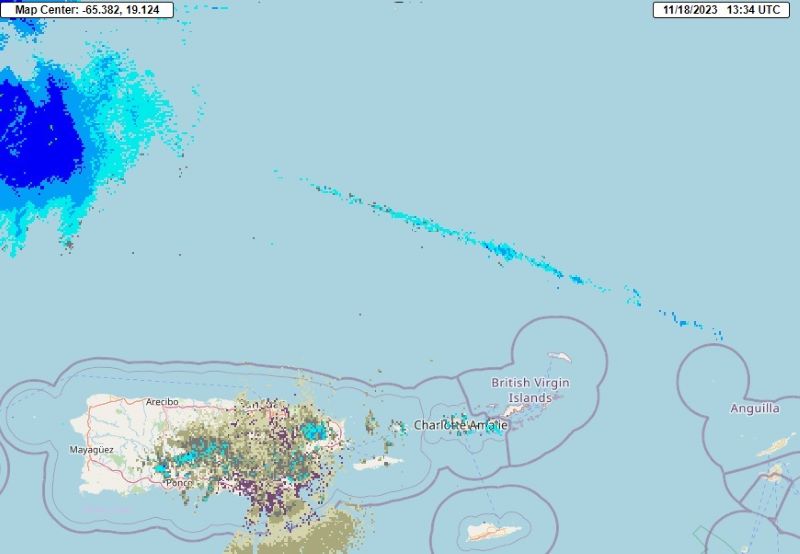
Starship met a fiery end near Puerto Rico
After SpaceX launched its 2nd Starship test flight on November 18, 2023, the 1st stage exploded shortly after separation from the main spacecraft. That explosion occurred over the Gulf of Mexico. Astronomers, other experts, weather radar images, witnesses and videos all suggested Starship continued its flight toward the Caribbean for a few minutes. Then, around 8 minutes into the flight, Starship appeared to come to an explosive end, with a reentry just north of Puerto Rico and the U.S. Virgin Islands.
According to sighting reports, Starship disintegrated near Puerto Rico around 9:15-9:16 a.m. AST (13:15-13:16 UTC) on Saturday.
Jonathan McDowell of the Harvard-Smithsonian Center for Astrophysics said:
I infer an impact point in the Atlantic at about 13:19 UTC near 65W 19N, north of Puerto Rico and the U.S. Virgin Islands. Indeed, a debris cloud was detected in NOAA weather radar data at that time and location, confirming this analysis.
Marco Langbroek, a satellite and orbital tracking expert, also agrees that Starship appears to have reentered in the Caribbean:
(Trajectory) brings it near the debris trail north of Puerto Rico as observed by weather radar.
And NOAA/NWS radar detected a reentering debris field near Puerto Rico.
The 2024 lunar calendars are here! Best Christmas gifts in the universe! Check ’em out here.
Radar loop of debris field from NWS San Juan radar. pic.twitter.com/IdxzVCWty6
— AnthonyCarl8610 (@ACarl8610) November 18, 2023
Closeup of the breakup

Eyewitness reports
One of the witnesses, a sports photographer, was with camera in hand taking pictures of surfers at a beach in Dorado, Puerto Rico. Jankiel Carranza, of JCJ Photos, said:
I saw this blazing object falling from the sky from northwest to northeast. I took a picture probably near the end of the sighting, but the object was even brighter just a few seconds before.
Carranza was able to capture the reentry with a camera using a 70-300mm zoom lens. His picture is a remarkable one, because it clearly shows a disintegrating object with noticeable fragmentation, leaving smaller objects or debris behind, which is characteristic of a manmade object reentry, and not a natural object such as a space rock (meteor).
At last contact, Starship was still at a 92-mile (148-km) altitude and traveling at around 15,000 miles per hour (24,000 kph), probably with propulsion. This means that any trajectory deviation or altitude loss would cause it to disintegrate through the atmosphere while still showing a huge speed. This description coincides with the object seen in this video taken from Puerto Rico.
Angélica Pérez, another witness to the event, said:
The object showed noticeable fragmentation, leaving smaller pieces behind the main, bright and golden object.
Here’s another video from San Juan, Puerto Rico, by Elias Sobrino Najul.
Many people in Puerto Rico, Anguilla and British Virgin Islands reported that they heard an explosion-like sound, and even felt a rumble, around 9:16 a.m. AST, which coincides with the time of the Starship reentry over the Caribbean. This suggests a good\-sized mass of the object was reentering the atmosphere, and since Starship was covered with thermal protection tiles, it cannot be ruled out that some considerable debris might in fact have reached the surface (ocean) in the eastern Caribbean.
A view from the Florida Keys
Although some people initially thought that Starship’s second stage also exploded over the Gulf of Mexico, this image taken from the Florida Keys suggests the spacecraft, with fins visible, was still intact when passing by that area during its flight.
Please let me know if my tracking shot of the Starship debris from the Florida Keys after its explosion could be of any use to you, I'd be happy to provide the raw footage. pic.twitter.com/AmZ1vgNmaY
— Astronomy Live (@astroferg) November 19, 2023
Reentry maps


Bottom line: After the launch of Starship on November 18, 2023, the spaceship seems to have triggered its self-destruct mode around 8 minutes in. Witnesses around Puerto Rico saw what they believe to be its fiery reentry.











